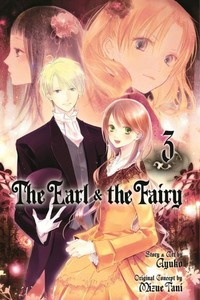Review
by Rebecca Silverman,The Earl & the Fairy
GN 3 & 4
| Synopsis: |  |
||
Following the events that lead to Edgar assuming the title of the Blue Knight Earl, Lydia finds herself living in London with her father and working as Edgar's personal fairy doctor. She's not thrilled about this but her boredom quickly wears off when rumors of a malicious fairy known as “The Fogman” begin circulating in connection with a series of kidnappings. When Lady Doris Walpole vanishes, Lydia and Edgar begin investigating. Is The Fogman really behind Doris' disappearance? Or is there another bogey at work? |
|||
| Review: | |||
Based on the second of twenty-nine novels in the light novel series of the same name by Mizue Tani, The Earl and the Fairy's final two manga volumes covers a complete storyline while still not giving us a feeling of completion in terms of the overarching tale of Lydia, Raven, and Edgar, thus providing a conclusion that is only partially satisfactory. Looked at by themselves, the tale of Lady Doris' abduction by persons or creatures unknown are entertaining pieces of period fantasy with likable, interesting characters and faithfulness to the Victorian era and British folklore, and it is in this capacity that readers should endevour to enjoy them, mostly because otherwise they leave us hanging and lamenting the fact that neither the light novels nor the anime (which appears to go a bit deeper into the story) are legally available in English. Volume three begins two months after Lydia inadvertently became Edgar's personal fairy doctor. She isn't entirely certain how this transpired and she still finds herself grappling with trust issues where the Earl is concerned. Nico, her familiar in the shape of a cat, doesn't help, as he is convinced that there is something shady about Edgar and would like Lydia to get away from him. Edgar, meanwhile, seems to be making an attempt at courting Lydia, who doesn't appear to get it. All of these themes form the underlying framework of the books, and while the action of the plot is interesting and in some cases exciting, it is really their relationship that is at the heart of the volumes. The nominal plot revolves around the disappearance of Lady Doris Walpole, a young noblewoman who has been living with her cousin Rosalie and their uncle. As children the girls made a promise on a “fairy egg,” a type of agate, and now Rosalie appears to be using that youthful superstition against her cousin. Rosalie and Doris made the acquaintance of Edgar at a society function, and Rosalie was instantly smitten. When Edgar gives Doris a ride home one day (a glaring social fault in the storytelling), Rosalie becomes jealous. Shortly thereafter, Doris vanishes. Lydia quickly determines that a bogey-beast, a malicious fey, is somehow involved in this, but just who is controlling him is unclear. As she tries to figure it out, she learns that Edgar has ties to the mysterious fairy egg and that he was connected, albeit briefly, to Doris and Rosalie in his tortured past. More secrets are revealed and his motivations shown more clearly while still making it uncertain just how much of a scoundrel he is and exactly what his feelings for Lydia are. Volume four does a very nice job of showing how conflicted his emotions towards her are, and the character of Raven also elucidates the issue a bit, while still keeping his own role murky. Ultimately that is the major issue with this as the end of the manga series – there are a lot of pieces of the story that are still in the dark. While the books themselves are very nicely done, the ending is far from final, and not in a way that allows the reader to make up her own sequence of events that would follow “The End.” Simply put, this is clearly an unfinished story, and no matter how enjoyable it is, the fact that we are unlikely to know how it really ends taints the final pages. Fortunately Ayuko continues to provide lovely art to accompany the story, with nice attention to period detail. Women's skirts have palpable weight to them (remember, women could be wearing up to 40 pounds of clothing in the mid-19th century) and the backgrounds, while not quite Emma quality, have an admirable sense of place and time. Fairies are clearly inspired by both the work of Brian Froud and traditional texts of the period, and strike a very nice visual note. Ayuko can overdo the tone in places, but she overall provides the story with an atmospheric art that suits it well. The Earl and the Fairy may not end as neatly as we would have liked, but it is still an enjoyable series. Firmly rooted in its place and time and incorporating many elements of the 19th century romantic tradition (there are very few overt physical demonstrations of affection), it gives us an exciting, interesting historical fantasy. If taken for what it is, this is a shoujo treat that doesn't fall into many of the pitfalls the genre, and given that this is what we've got, that is the best way to read this series. |
| Grade: | |||
|
Overall : B+
Story : B+
Art : B-
+ Great ties to its setting both in writing and art, slow reveal of Edgar's motives and question of his emotions keeps us reading. |
|||
| discuss this in the forum (1 post) | | |||
| Production Info: | ||
|
Full encyclopedia details about Release information about |
||